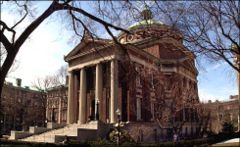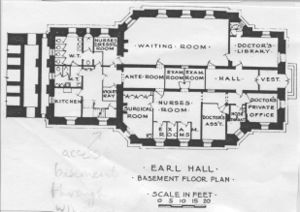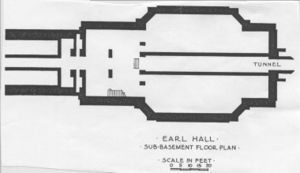Difference between revisions of "Earl Hall"
| Line 19: | Line 19: | ||
==Photos== | ==Photos== | ||
| − | [[Image:Earlbasement.jpg|thumb| | + | [[Image:Earlbasement.jpg|thumb|left|Earl basement map]] |
| − | + | The first map (of the Earl Hall basement) shows the building's old hospital configuration, which no longer applies. Note the "violet ray", an old quack medical device that used corona from electric sparks to supposedly heal anything. Also note the secret staircase in the doctor's library. | |
| − | [[Image:Earlsubbasement.jpg|thumb| | + | [[Image:Earlsubbasement.jpg|thumb|left|Earl sub-basement map from 1940s]] |
| − | + | The second map (of the Earl Hall sub-basement from the 1940s) is still largely accurate, except that the staircase is blocked off at the top. | |
[[Category:Buildings on the Morningside Heights campus]] | [[Category:Buildings on the Morningside Heights campus]] | ||
Revision as of 03:39, 7 March 2008
Earl Hall is Columbia's religious and community service HQ. Previously, Earl served as Columbia's student health center and had medical offices in the basement level.
Earl has some lovely rooms, including the Dodge Room overlooking Broadway, and the auditorium on the upper floor, which is often used for "town hall" events. Most campus religious groups have an office in here. Ironically, the Chaplain's Office is not located here. She called dibs on a space in Lerner Hall when it opened. Her vacant office is now occupied by the head of CUIT.
Tunnel connections
Mathematics
- Access: You must get into the sub-basement first, which is trickier than it seems. Until approximately 2003, the tunnels under Earl could be easily accessed from a branch off of the north-south tunnel that extends from Dodge Hall to Havemeyer. Unfortunately, new construction has put a locked door at the top of the stairs that used to lead from this tunnel up into Earl, and there is no entrance into these tunnels from Earl itself. But fortunately, it's still possible to access these tunnels without having to break through locked doors because the building has several windows at ground level which can be used to enter the tunnels. Walk to the north wall of Earl and you will find that one of the windows has a pipe running through it. Pry up this window and enter. It is difficult because there are many layers of dried paint caked onto the window frame, but it will open. The exit to the tunnels is at the west end of the sub-basement. Mathematics is to your right once you go down the stairs into the tunnel. Havemeyer lies beyond.
- Security/difficulty: Rating 6/10. No alarms or cameras, but it is obviously risky to be in plain sight prying open a window to a building. Definitely never to be attempted during daylight. 6/10 for moderate security risk.
Lewisohn
- Access: Same as the Mathematics connection, but instead you turn left. Dodge Hall lies beyond, and then Journalism and Furnald if you are lucky.
- Security/difficulty: Rating 6/10. Same as above.
Notes
The Earl tunnels are among the more interesting ones on campus because they are relatively unused and not frequently cleaned or maintained. Expect to find a bunch of discarded beer cans scattered about, among other things. It's possible that there's a tunnel to Low Library, but this hasn't been discovered yet.
Photos
The first map (of the Earl Hall basement) shows the building's old hospital configuration, which no longer applies. Note the "violet ray", an old quack medical device that used corona from electric sparks to supposedly heal anything. Also note the secret staircase in the doctor's library.
The second map (of the Earl Hall sub-basement from the 1940s) is still largely accurate, except that the staircase is blocked off at the top.


